From Sarong Island With Love: Singapore’s Original Tourist Isle
Before there was Sentosa, there was Sarong Island.
By Lim Tin Seng
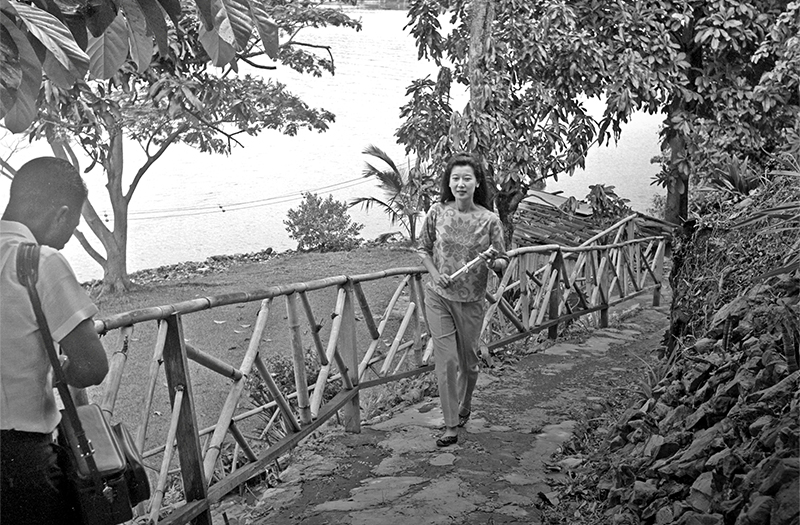
For many people, Sentosa is a leisure and tourist destination with a tropical getaway vibe (indeed, it now bills itself as “Singapore’s Island Getaway”). However, before there was Sentosa, Singapore had another tourist isle that was marketed as a getaway from the busy city. A print advertisement from 1967 beckoned people to:
“Come to the island…
across calm and moonlit waters,
to look at beauty…
guarded by white marble carved into
serene eyes and silent lips,
that speak only to our inner hearts.1
This island was Sarong Island, a place where one could “dine, dance, watch floor shows or just sip a drink and watch a breathtaking view of Singapore harbour and the great ships that pass in and out day and night”. There, you could see “over a hundred varieties of tropical trees and flowers, many species of wild birds, occasional visits of groups of chattering monkeys… [and] the rare sight of a giant monitor lizard basking in the sun”.2
Sarong Island was a piece of land about the size of three football fields (190,575-square-foot; 1.8 ha) that used to sit just off the northern coast of Sentosa. The island was near the former Sentosa Ferry Terminal before it was reclaimed and merged with Sentosa. Dubbed “Singapore’s first tourist isle”, Sarong Island was given its name by its former owner, the late Christina Lee (1923–2009), and was even referred to as the “Shangri-La” of Singapore.3
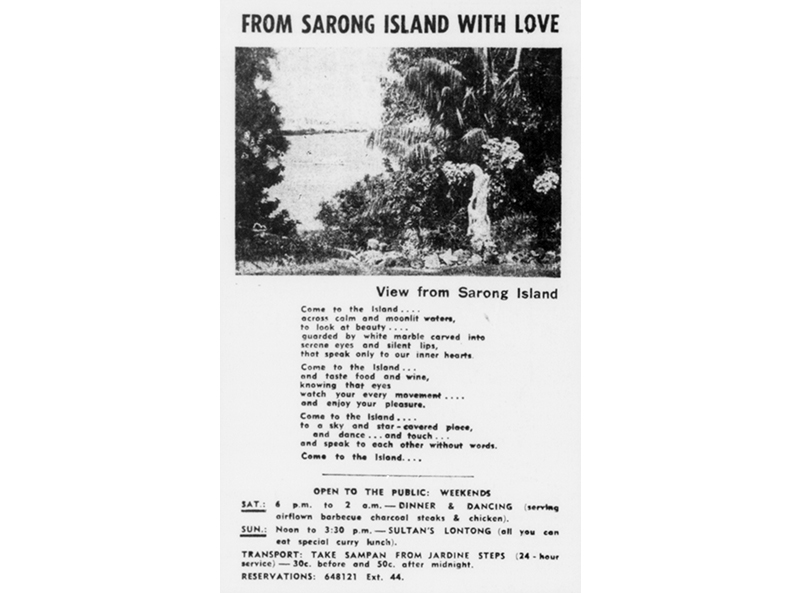
An Island for Sale
Before the war, the main feature of the island was a three-bedroom bungalow perched on top of a hill. Known as the “White House”, the bungalow was built by Frank Blackwood Sewell who served as Senior Superintendent of Surveys of the Straits Settlements from 1927 to 1932. In 1947, Sewell sold the house to E.J. Bennett, who left Singapore on board the HMS Grasshopper on 14 February 1942, one of the last vessels to evacuate during the Battle of Singapore.4
After Bennett died in 1950, the house and the island – which was connected to Pulau Blakang Mati (now Sentosa) by a footbridge – were put up for sale by the Chartered Bank Trustee Limited in 1957 for $95,000 (Malayan dollars) “or [a] reasonable offer”. At the time, the island still had 89 years left on its lease and the White House was described to be “in good repair and has electric light, telephone, water and modern sanitation”. But the sale, which was advertised several times, failed to attract buyers except for the Jesuits who wanted to turn the island into a retreat. However, they could not afford it and the deal did not materialise.5
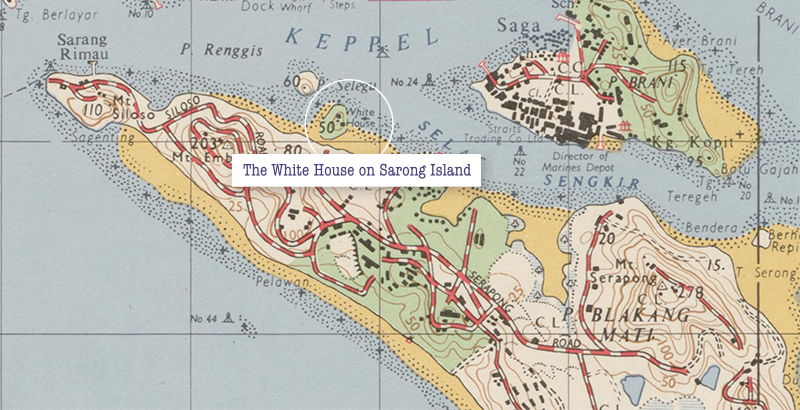
In the end, the island and bungalow were purchased by well-known socialite Christina Lee, the second wife of cinema magnate Loke Wan Tho. In an oral history interview in 2001 (by then she was married to Indian psychiatrist and businessman Dadi Balsara),6 she recalled that it was her brother who brought the island to her notice.
“My brother rang me one day. He told me, ‘I want you to come and see a piece of land with me.’… and then he took me in a car and went to the pier… we went into a boat and then five minutes later, we landed on an island. We walked up the hill and there was this house called the ‘White House’… It was so beautiful, and I really fell in love with it.”7
Lee was supposed to purchase the island together with her brother. However, he ended up buying land elsewhere and had no money leftover, so she became the sole owner towards the end of the 1950s.
The island’s pristine, natural environment was home to many species of wildlife, and Lee started exploring the island, documenting its fauna, particularly its birds, with her camera. A number of her photographs were reproduced in the 1964 issue of the Straits Times Annual in “Birds of Pulau Selegu”, an article by former Commissioner-General for Southeast Asia Malcolm MacDonald (1948–55). (Before it was renamed Sarong Island in 1967, the island was widely referred to as Pulau Selegu, even though Pulau Selegu was the name of a different, though nearby, island).8
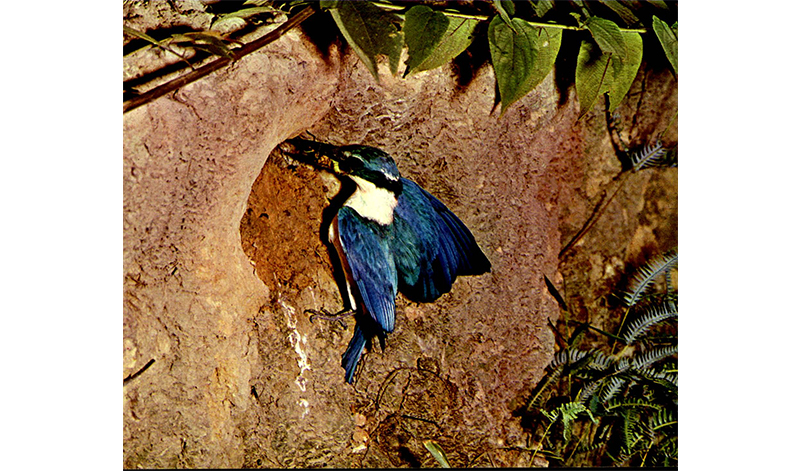
Lee was a skilful wildlife photographer, recognised as a “first-rate photographer of birds” and even “The Secretary [of] Birds”. Her photographs of birds such as the white-collared kingfisher and the yellow-breasted sunbird were described as “stunning” and “impossible to describe [without] an exaggeration of eulogy”.9
Becoming Sarong Island
In the early 1960s, Lee decided to live in the White House after she separated from Loke Wan Tho. Living on the island had its challenges and she recalled: “I had to do all my shopping in Singapore… my brother also came to stay with me with his two children… we [had] to shuttle to and fro the whole time in sampan…”. There were advantages though. “It was so beautiful at night looking at the sea and the ships coming in. And sometimes some of the captains knew me and they would hoot their horns!”10

The walk from the sampan to the White House was also a bit of a journey, as the Straits Times noted when it reported how Lee’s guests had arrived on the island for a party in 1962. After stepping out from the sampan as gracefully as they could, the guests had to “climb a steep hillock through a winding cemented pathway to reach the house. Some of the lady guests, who had been there before, were armed with an extra pair of low-heeled shoes. Those invited for the first time had the experience of walking like an acrobat on a tightrope.” It was worth it, though, said the paper. “The cool breeze, the beautiful scenery, the far-away lights, and the moon throwing its soft radiance on passing shops… make Christina’s ‘White House’ like Shangri-La.”11
In 1964, Lee decided to turn the island into a “pleasure island” that she wanted to call Pulau Chantek (meaning “Beautiful Island” in Malay). This was later changed to Sarong Island because as Lee’s then husband, the film actor and producer Jeffrey Stone, explained in 1967, “the word sarong is known throughout the world. And it is a word which is easy for Westerners to remember”.12
Lee had ambitious plans to turn the island into a tourist resort. The multi-million-dollar project called for the construction of numerous amenities, including a seawater swimming pool, bowling alleys, a floating restaurant, a night club for members only and 50 chalets each equipped with “a sitting room, a kitchenette and a bedroom with bathroom”. These chalets were for tourists who wanted to spend the weekend or longer on the island. To attract tourists, “a fleet of small ferry boats operating round-the-clock to provide a 30-cent four-minute ride to and from Jardine Steps” was put in place.13
According to Lee, Law and National Development Minister E.W. Barker helped her to make Sarong Island happen. “I knew his wife and we used to play mahjong together…,” she said. “[So] I invited him and his wife to the island. And he liked it very much as he thought it was beautiful… and I asked Eddie Barker to help me, and he did. Soon after that I got the approval to turn it into a restaurant.”14
Sarong Island Opens
Sarong Island was declared open on 22 September 1967 by Barker, an event that was witnessed by several hundred guests. They arrived by sampan to the island amid “brilliant lighting effects” from Clifford Pier and Jardine Steps, and were “entertained to a dinner of local dishes” and “a multi-racial show”.15
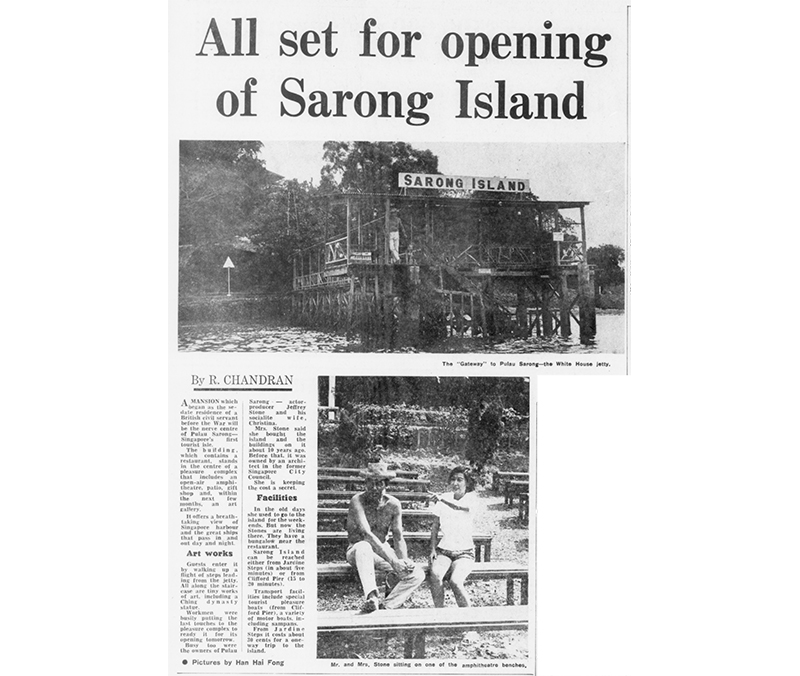
The Sarong Island of 1967 was a scaled-down version of Lee’s original vision. The main focus was the restaurant (the White House), though it also had an open-air amphitheatre for dance performances, an outdoor patio to hold events, a gift shop, a proper pier, and artworks from Lee’s private collection adorning the flight of steps leading from the jetty to the restaurant. The entire island was also wired for music and lighting.
The restaurant served “curry buffet with added European dishes” for lunch on Sundays, and “air-flown steaks, imported capon chicken and whole rock lobster” for Saturday-night dinners amid music and dance performances by local groups.16
Among those who performed on the island was Santha Bhaskar, who would later become a Cultural Medallion recipient. She danced with her group on the island and recalled the allure of the place in an oral history interview in 2009: “[W]e used to go to Sarong Island by boat… It [had a] very nice setting, you know, very beautiful setting at Sarong Island… Christina’s husband was very artistic. So he decorated the place in such a way that tourists [would] come. It is like they are in a magic world you know.”17
Pianist and singer Danny Koh had also performed on Sarong Island. In a 2015 oral history interview, he vividly recalled how “romantic” and “special” the place was. His band played at the restaurant and the guests were all big spenders. “[T]hey were locals, those who liked to party around who liked to have dinner and all these things,” he said.18
The island could also be rented out for events ranging from private and company functions to graduation and award-giving ceremonies. The public could also use it for weddings and fashion shows.19
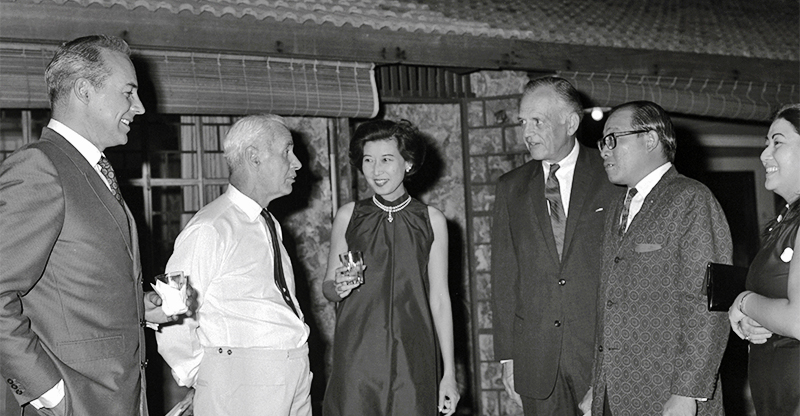
Lee initially continued living in the White House but eventually moved to another house on the island. “I built a little house right [by] the sea… I could open the windows and… see the next island. That small island now… with the pillar for the cable car [Pulau Selegu],” she recalled.20
A Short-lived Venture
To promote Sarong Island, advertisements ran in the press with taglines such as “From Sarong Island with Love”, “Singapore’s Finest Tourist Attraction”, and “Go Where the Beautiful People Go”. Guests were also promised gifts and prizes.21
One problem with beckoning people to Sarong Island “across calm and moonlit waters” was that the waters were not always calm, especially during the monsoon season. As Lee recalled: “[D]uring the end of the year when it rained, I realised that a lot of people would book the place… [But] they would not come because they had to come in a sampan. They would have to walk up the hill which was not sheltered… I realised those were the things that stopped people from coming.”22
To mitigate this problem, Lee promised to provide visitors with “complete shelter” from the jetty to the restaurant with the use of umbrellas and “Sarong Island straw hats”. However, it soon became clear to Lee that Sarong Island was difficult to sustain as a tourist attraction and a going business concern.23
In August 1968, a little less than a year after the island’s opening, a humorous notice was published in the newspapers to announce the restaurant’s closure. It said: “We’re not weather experts, but from past experience we expect a similar weather pattern at this time of year as last time. And… ‘boy does it rain!’ Therefore, the management and staff of Sarong Island would like to thank all customers and friends for their patronage and support. We also wish to take this opportunity to announce that the Sarong Island Restaurant will cease operation until further notice.”24
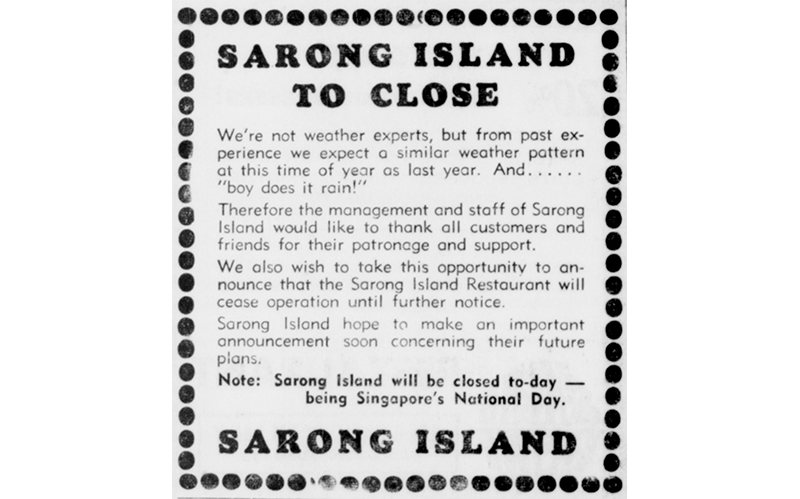
In 1971, the government issued a notice in the Government Gazette that it would be acquiring Sarong Island, along with a plot of land on Sentosa that was also owned by Lee. Amounting to a total 217,800 sq ft (2 ha), the acquisition came as the government revealed its plan to develop Sentosa into a tourist resort island.25 Lee was shocked and disappointed by the news.26
Joining Up with Sentosa
After acquiring Sarong Island, the government combined it with Sentosa via a land reclamation scheme. Announced in 1978, this $7 million project, which also included the nearby Selegu Island, took about two years to complete and added some 170,000 sq m (17 ha) of land to Sentosa.27 Today, Hard Rock Hotel Singapore occupies the land where Sarong Island once stood.28
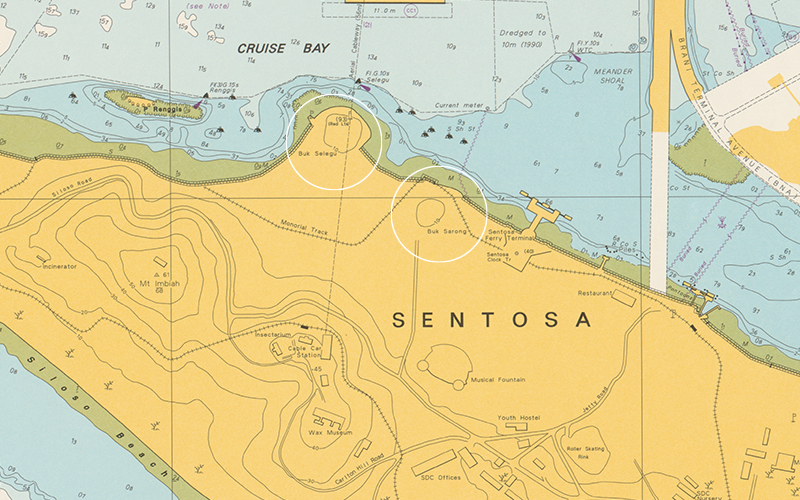
Although Sarong Island no longer exists, the island and Sentosa once shared the same destiny as a “tourist isle of Singapore”. In fact, back in the 1960s, Lee already had an inkling that her island would inspire the transformation of Pulau Blakang Mati into the island resort of Sentosa. “I had gardeners who looked after [my island] very well. In fact, somebody told me that when Lee Kuan Yew [then the prime minister of Singapore] visited Blakang Mati, he found that it was overgrown with grass… he looked across and said, ‘What is that?’ They said, ‘Oh that is Sarong Island.’ He said, ‘It is so beautifully kept so why can’t we do it?’”29
In the 1950s and 1960s, the island that became known as Sarong Island was regularly referred to as Pulau Selegu in press reports. However, Pulau Selegu was actually the name of another island, while Sarong Island originally did not have a name. For instance, a 1966 topographical map of Singapore shows that Selegu Island was located northwest of an unnamed island sitting along the northwestern coast of Sentosa (or Pulau Blakang Mati at the time). This unnamed island has a structure labelled “White House” in the map.
A 1979 survey map of the area also states that the lot and mukim (“district” in Malay) number for Sarong Island is “Lot 52 Mukim XXXIV”, which is the same as the one published in the 1971 acquisition notice in the Government Gazette. Pulau Selegu had a different lot and mukim number: Lot 196 Mukim XXXIV.
While these provide evidence that Sarong Island and Pulau Selegu were not the same island, we still do not know the original name of what was subsequently termed Sarong Island. A possible explanation could be that Sarong Island was a tidal island, a piece of land that is connected to the mainland at low tide and submerged at high tide. As such, it was not given a name and could be seen by surveyors as part of the bigger Blakang Mati (Sentosa) island.
In 1978, Law, Environment, and Science and Technology Minister E.W. Barker asked Parliament to approve a $7 million reclamation plan to link Sarong Island and Pulau Selegu to Sentosa, thus showing a distinction between the two islands. “The area proposed for reclamation is an eyesore at low tide when muddy flats, mangrove swamps and flotsam are exposed. The reclamation will join up Pulau Selegu and Sarong Island with Sentosa Island which will not only improve the visual impact on visitors, but will also create more land for future development,” he said.
The reclamation works that merged Pulau Selegu and Sarong Island with Sentosa were completed in 1980.
REFERENCES
Dunlop, Peter K.G. British Royal Air Force, Aerial Photographs from South-east to North-west Showing Pulau Blakang Mati, Pasir Panjang Wharf, 22 November 1949, photograph. (From British Royal Air Force Collection, National Archives of Singapore, accession no. 258513)
“For Sale: Isle Dream Home,” Straits Times, 16 March 1957, 5 (From NewspaperSG)
Parliament of Singapore, Reclamation at Sentosa Island, vol. 37 of Parliamentary Debates: Official Report, 31 January 1978, cols. 254–55. (From National Library, Singapore, call no. RCLOS 328.5957 SIN)
Republic of Singapore, Government Gazette. Extraordinary, 27 February 1971, G.N. 594, p. 641. (From National Library, Singapore, call no. RSING 959.57 SGG)
Survey Department, Singapore, Topographical Map of Central and Southern Singapore, and Singapore City, 1966, map. (From National Archives of Singapore, accession no. M2016_000173_SD)
Survey Department, Singapore, Mukim Number XXXIV: Other Islands, and Mukim Number 1: Telok Blangah, 19 June 1979, map. (From National Archives of Singapore, accession no. SP004294)
Survey Department, Singapore, Mukim Number XXXIV: Other Islands, 19 June 1979, map. (From National Archives of Singapore, accession no. SP004295)
“Two Islands to Link with Sentosa,” Straits Times, 2 February 1978, 28. (From NewspaperSG)
 Lim Tin Seng is a Senior Librarian with the National Library, Singapore. He is the co-editor of Roots: Tracing Family Histories – A Resource Guide (2013), Harmony and Development: ASEAN-China Relations (2009) and China’s New Social Policy: Initiatives for a Harmonious Society (2010). He writes regularly for BiblioAsia.
Lim Tin Seng is a Senior Librarian with the National Library, Singapore. He is the co-editor of Roots: Tracing Family Histories – A Resource Guide (2013), Harmony and Development: ASEAN-China Relations (2009) and China’s New Social Policy: Initiatives for a Harmonious Society (2010). He writes regularly for BiblioAsia.NOTES
-
“Page 5 Advertisements Column 1,” Straits Times, 14 October 1967, 5. (From NewspaperSG) ↩
-
“A Many Splendoured Island,” Eastern Sun, 23 September 1967, 5; R. Chandran, “Christina’s Isle of Joy to Be Opened on Thursday,” Straits Times, 16 September 1967, 7. (From NewspaperSG) ↩
-
“For Sale: Isle Dream Home,” Straits Times, 16 March 1957, 5 (From NewspaperSG); “HMS Grasshopper,” Malayan Volunteers Group, January 2021, https://www.malayanvolunteersgroup.org.uk/uploads/1/0/7/3/107387685/passenger_list_hms_grasshopper_version_1.2.2_jan_21.pdf. ↩
-
Gloria Chandy, “Lady of Fragrances,” New Paper, 28 May 2000, 11. (From NewspaperSG) ↩
-
Mrs Christina Balsara, oral history interview by Patricia Lee, 18 July 2001, MP3 audio, Reel/Disc 4 of 9, 30:28, National Archives of Singapore (accession no. 002542). ↩
-
“Two Islands to Link with Sentosa,” Straits Times, 2 February 1978, 28; “Sentosa Cable Car Towers to Go Up Soon,” Straits Times, 26 June 1972, 9. (From NewspaperSG) ↩
-
Malcolm MacDonald, “Birds of Selegu,” Straits Times Annual, 1 January 1964, 38–39; Hasnah Vimala-Chen, “And with Fond Memories of My Childhood,” Straits Times, 27 October 1963, 6; Gerald Wilkins, “Malaysian Scene in Picture and Story,” Straits Times, 4 November 1963, 13; “The Secretary-birds,” Straits Times, 15 September 1963, 17; “The Scorching Personal Picture of a Rhino Coming in for the Kill,” Straits Times, 6 June 1965, 3; “Scent of a Woman,” Straits Times, 9 August 2003, 10. (From NewspaperSG) ↩
-
Mrs Christina Balsara, oral history interview, 18 July 2001. ↩
-
“Party for MacDonalds at ‘White House’,” Straits Times, 26 April 1962, 14. (From NewspaperSG) ↩
-
Mrs Christina Balsara, oral history interview, 18 July 2001; “Christina’s Isle of Joy.” ↩
-
“Pleasure Isle for Tourists,” Straits Times, 29 February 1964, 1. (From NewspaperSG) ↩
-
Mrs Christina Balsara, oral history interview, 18 July 2001. ↩
-
“Christina’s Isle of Joy”; “Brilliant Backdrop Sets Mood for Opening of Sarong Island,” Straits Times, 23 September 1967, 9. (From NewspaperSG) ↩
-
R. Chandran, “All Set for Opening of Sarong Island,” Straits Times, 20 September 1967, 7; “Page 6 Advertisements Column 2,” Straits Times, 18 November 1967, 6 (From NewspaperSG); “Brilliant Backdrop Sets Mood.” ↩
-
Mrs Santha Baskar, oral history interview by Nur Azlin Salem, 23 September 2009, transcript and MP3 audio, Reel/Disc 5 of 8, 56:48, National Archives of Singapore (accession no. 003390), 166–67. ↩
-
Daniel Koh Yew Bin, oral history interview by Mark Wong, 24 March 2015, MP3 audio, Reel/Disc 6 of 13, 39:19, National Archives of Singapore (accession no. 004011). ↩
-
“Page 4 Advertisements Column 2,” Straits Times, 17 January 1968, 4. (From NewspaperSG) ↩
-
Mrs Christina Balsara, oral history interview, 18 July 2001. ↩
-
“Page 15 Advertisements Column 3,” Straits Times, 30 December 1967, 15. (From NewspaperSG); “Page 6 Advertisements Column 2”; “Page 5 Advertisements Column 1.” ↩
-
Mrs Christina Balsara, oral history interview, 18 July 2001. ↩
-
“Page 6 Advertisements Column 1,” Straits Times, 9 August 1968, 6. (From NewspaperSG) ↩
-
“Aim to Put Singapore on the World’s Perfume Making Map,” Straits Times, 23 September 1977, 36; “Mrs. Stone ‘Still in Shock’ Over Govt Take-over of Tourist Isle,” Straits Times, 3 March 1971, 6; “$11.5M to Develop Sentosa,” Straits Times, 27 March 1971, 3. (From NewspaperSG) ↩
-
“Mrs. Stone ‘Still in Shock’ Over Govt Take-over of Tourist Isle.” ↩
-
Parliament of Singapore, Reclamation at Sentosa Island, vol. 37 of Parliamentary Debates: Official Report, 31 January 1978, cols. 254–55. (From National Library, Singapore, call no. RCLOS 328.5957 SIN) ↩
-
“Hard Rock Hotel Singapore Opens at Resorts World Sentosa,” Hard Rock International, 27 January 2010, https://www.prnewswire.com/news-releases/hard-rock-hotel-singapore-opens-at-resorts-world-sentosa-82773492.html. ↩
-
“About Us,” Sentosa Development Corporation, accessed 19 July 2022, https://www.sentosa.com.sg/en/about-us/; Mrs Christina Balsara, oral history interview, 18 July 2001. ↩

